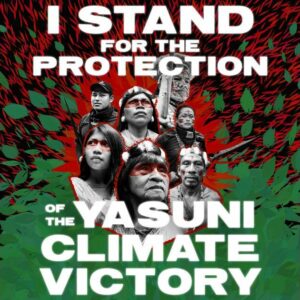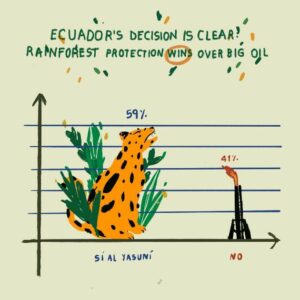Edited by Daniel Voskoboynik and Sophie Pinchetti
A Peruvian court has issued a landmark on October 31, 2024 ruling recognizing the comprehensive land rights of the Indigenous communities of Mashunta, San Martin de Porres, and Vencedor, all part of the Siekopai (or Secoya) nation. By compelling the Regional Agricultural Directorate of Loreto to grant full land titles to these communities, this decision marks a massive victory for Indigenous rights, cultural preservation, and environmental justice in Peru and across the world. This ruling comes over a year after the Siekopai celebrated a major landback victory in Ecuador, marking another pivotal step in their ongoing struggle to reunify their ancestral territory across state-imposed borders.
For years, the Siekopai nation fought to defend their ancestral lands from legal and political restrictions, which limited their property rights. By granting the communities full property titles rather than mere use rights, this historic court decision advances the legal recognition of ancestral lands and affirms the critical role of Indigenous nations as custodians of some of the world’s most important ecosystems.
The victory, achieved through continuous advocacy and organizing over the years, demonstrates the resilience of Indigenous communities in defending their heritage and future.
Background of the Case
The Siekopai communities of Mashunta, San Martin de Porres, and Vencedor have lived in harmony with their ancestral lands in the Peruvian Amazon for generations. Their connection to the land goes far beyond physical possession; it is a spiritual and cultural bond deeply rooted in their traditions and practices. Despite this, national policies and laws in Peru have historically limited or impeded Indigenous Peoples’ rights of use, administration, and protection over their ancestral territories. The current system can declare Indigenous territories as property of the State, making ancestral property invisible and violating the rights of the nationality. This has left Siekopai territories vulnerable to encroachment, exploitation, and dispossession.
Faced with these threats, the Siekopai communities took legal action – with the support of Amazon Frontlines and our allies at the Legal Defense Institute (IDL) – to secure full recognition of their territories. Their case argued that Peruvian national laws restricting land use rights violated the community’s constitutional and international rights to their lands, as stipulated by agreements such as the International Labor Organization (ILO) Convention 169. Supported by Indigenous organizations and legal experts, the case became a rallying point for Indigenous land rights advocates throughout Peru and beyond.
A Triumph Advancing Indigenous Land Rights in Peru
The court ruled in favor of the Indigenous communities, ordering the Regional Agricultural Directorate of Loreto to rectify existing titles and grant the communities full ownership of over 300,000 acres of ancestral lands. This decision overturns previous laws that limited Indigenous land rights to temporary use, acknowledging these restrictions as violations of their constitutional and international rights. The court’s ruling emphasizes the importance of protecting Indigenous territories as a matter of justice and cultural preservation.
This landmark ruling reaffirms Indigenous peoples’ autonomy over their lands, empowering them to better defend their territories from external threats like deforestation, mining, and illegal logging. The decision also highlights these communities’ deep spiritual and cultural connections with their lands, which are essential to their identity, their way of life, and their guardianship of the Amazon rainforest.
Indigenous Perspectives on Territory and Spiritual Connection
For many Indigenous communities, the borders that define modern nation-states are remnants of colonial impositions that fragmented territories and disregarded traditional ways of living. For the Siekopai and countless other Indigenous peoples, their lands transcend legal boundaries; these territories are sacred spaces imbued with meaning, memory, and identity. Their land is their home, pharmacy, and supermarket, where medicinal plants are gathered, food is hunted or cultivated, and culture is practiced. For these communities, a land title is more than a legal document; it is a recognition of their rightful and legitimate home, an acknowledgment of centuries of existence and ancestral resilience.
Western perspectives often fail to fully grasp this deep attachment, solely seeing territories through a lens of economic value, where all land is a commodity to be owned, developed, or exploited. Yet, for the Siekopai people, the territory is a living being; its protection is an act of spiritual duty and collective memory. It is a commitment to their ancestors and future generations, ensuring that the forests, rivers, and sacred sites remain vibrant and protected.
“This is more than a victory for our land; it is a victory for our culture, our future, and our children,” declared Siekopai leader Edgar Neyser Gaños Mendoza of the Mashunta community. “Our lands are sacred, and this ruling confirms what we have always known—they belong to us, and we belong to them.”
For Indigenous rights organizations, including Amazon Frontlines, this ruling is a milestone and precedent for environmental protection and defending Indigenous sovereignty more broadly in Peru and across the Amazon. “This victory is not just for the Siekopai but for Indigenous communities everywhere who are fighting for their lands,” said Amazon Frontlines lawyer and human rights defender Jorge Acero.
Why Land Titling Matters for Indigenous Leadership in Biodiversity Conservation
Recognizing and formalizing Indigenous land rights is a critical step toward preserving global biodiversity and empowering Indigenous leadership. Research shows that lands managed by Indigenous peoples have lower deforestation rates, richer levels of biodiversity, and healthier ecosystems. Indigenous stewardship, after all, is rooted in centuries of traditional knowledge, sustainable practices, and a profound interrelation with nature.
The lands of the communities of Mashunta, San Martin de Porres, and Vencedor are more than resources; they are the lifeblood of their culture and survival. Their knowledge of the land allows them to cultivate, hunt, fish, and preserve their forests in ways that maintain ecological balance. By granting full land ownership, the court empowers these communities to continue their role as guardians of the Amazon rainforest, which is critical in combating climate change and maintaining global environmental health.
Indigenous leadership is essential in the fight against climate change. When Indigenous communities have secure rights to their land, they can better protect forests from exploitation, advocate for sustainable policies, and ensure that traditional practices are respected. The court’s ruling is a testament to their leadership and a recognition of their essential contributions to environmental preservation.
The Battle Ahead Against the Peruvian Government’s Appeal
While the court’s decision favoring the Siekopai Nation is a groundbreaking moment for Indigenous land rights, it has faced significant opposition from the Peruvian government. Various ministries have filed an appeal challenging the ruling, arguing that it oversteps legal and procedural boundaries.
The government argues that the legal process invoked by the Siekopai is ill-suited for establishing new rights or overturning existing laws, asserting that the judgment oversteps the judiciary’s mandate. Officials further contend that the ruling failed to properly account for technical assessments and existing legal frameworks, which designate much of the disputed land as inalienable forest reserves. Additionally, the government raises concerns about national security, citing the contested lands’ proximity to international borders.
At its core, however, the government’s position denies the fundamental rights of the Siekopai to their ancestral lands, dismissing centuries of stewardship and cultural connection in favor of colonial legal frameworks and economic interests.
As we look towards the battle ahead, we stand with our Siekopai partners in their struggle for Land Back in the Amazon Rainforest. Please consider donating to support our ongoing work defending Indigenous land rights and help us to build a future where Indigenous peoples and their lands are respected and protected.




